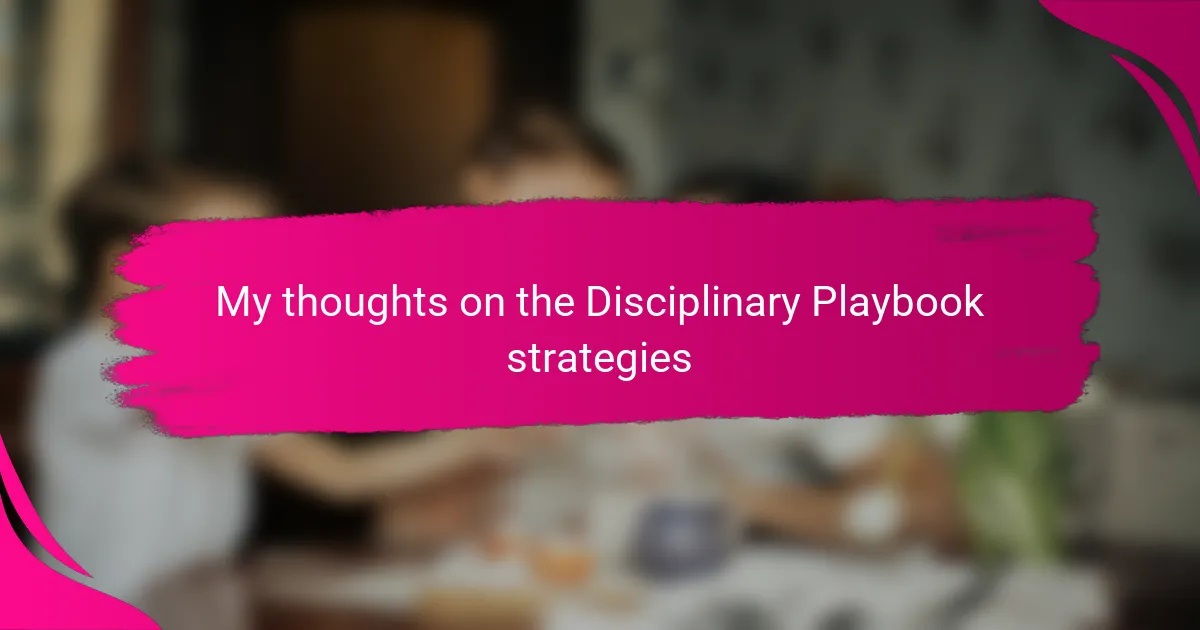Key takeaways
- Disciplinary playbooks provide structured approaches to manage children’s behavior, fostering predictability and security.
- Clear expectations, natural consequences, and positive reinforcement are effective strategies that encourage good behavior and responsibility.
- Taking small, manageable steps and maintaining routines helps ease the implementation of discipline strategies and fosters a supportive environment.
- Consistency and celebrating small wins are essential for nurturing positive behavior and improving parent-child communication.

Understanding Disciplinary Playbook Basics
Disciplinary playbooks offer a structured yet flexible approach to managing children’s behavior, breaking down complex challenges into manageable steps. I’ve found that understanding these basics helps me stay calm and consistent, even when my child tests boundaries. Have you ever wondered why sticking to a clear plan makes such a difference in preventing power struggles? It’s because the playbook creates predictability, which children—just like adults—crave for feeling secure.

Key Strategies in Parenting Discipline
One strategy I’ve come to rely on is setting clear, consistent expectations. When my kids know exactly what’s expected, they respond with less resistance. It’s amazing how much smoother things run when everyone’s on the same page—don’t you think clarity helps reduce frustration on both sides?
Another key approach is using natural consequences instead of harsh punishments. I once let my daughter face the results of leaving her bike out in the rain; she learned to be more responsible without feeling punished. Hasn’t it felt more effective when consequences feel fair and connected to the behavior?
Finally, I believe that positive reinforcement is a game-changer. Praising good behavior, no matter how small, builds motivation and a trusting relationship. Have you noticed how children light up when you acknowledge their efforts rather than just pointing out mistakes? This strategy really helps nurture long-term good habits.

Practical Steps for Implementing Strategies
I started by choosing just one or two strategies from the playbook to focus on, which made the whole process feel less overwhelming. Have you ever tried changing everything at once and ended up more stressed than your child? Taking small, manageable steps not only helped me stay consistent but also gave my kids the time they needed to adjust.
Creating a simple routine around these strategies made a huge difference for us. For example, setting a specific time each day to discuss expectations or review consequences helped my kids know what to expect and gave us a chance to check in. Have you noticed how routines can turn tricky moments into predictable ones that feel safer for everyone?
I also found that keeping a journal of what works and what doesn’t was incredibly eye-opening. When I saw patterns in my child’s reactions, I could tweak my approach instead of throwing the whole plan out the window. Does tracking progress sound tedious? Honestly, it became a tool that made me feel more in control and hopeful, even on tough days.

Common Challenges and Solutions
One challenge I often faced was staying patient when my child repeatedly tested the same boundary. It’s tough not to feel frustrated, but I learned that reminding myself the playbook’s strategies are a process—not a quick fix—helped me stay steady. Have you ever noticed that when you model calm persistence, your child gradually mirrors that calm?
Another hurdle was tailoring the strategies to fit my child’s unique personality. What works for one kid might feel like a mismatch for another, and that trial-and-error phase can be discouraging. I found that keeping an open mind and adjusting my approach with small tweaks made the playbook feel less like a rigid manual and more like a flexible toolkit.
Finally, consistency sometimes felt impossible amid the chaos of daily life. There were days when fatigue or unexpected events made sticking to routines a real struggle. But I realized that forgiving myself for these off days and simply picking up the playbook again the next moment was key. Have you found that embracing imperfection actually strengthens your discipline efforts over time?

Personal Experiences with the Playbook
Using the Disciplinary Playbook has been a mixed bag for me personally. There were moments when sticking to the playbook’s steps felt like navigating a maze blindfolded—especially during those stubborn tantrums. Have you ever felt utterly drained but still had to keep your cool? That’s exactly how it was, and it taught me how important patience really is.
I remember one time when a specific strategy—offering choices instead of commands—completely shifted the mood at home. My son went from defiant to cooperative almost instantly, which felt like a small victory worth celebrating. Doesn’t it amaze you when a simple shift suddenly unlocks better communication?
Of course, not every tactic worked perfectly on the first try, and sometimes I questioned if I was doing it right. But over time, seeing even tiny improvements convinced me the playbook was less about perfection and more about progress. Have you experienced that rewarding feeling when persistence starts to pay off? That’s when I truly believed in the process.

Tips for Consistency and Success
Consistency became my cornerstone for success when using the playbook—I quickly realized that even small lapses could confuse my child and undo progress. Have you noticed how children thrive when they know what to expect every single time? That predictability offers a sense of security that really supports positive behavior.
Another tip I’ve embraced is creating gentle reminders for myself—whether it’s a simple note or setting alarms—to keep discipline practices front and center during busy days. It’s easy to drift off course when life gets hectic, isn’t it? These little prompts helped me stay aligned with my goals without feeling overwhelmed.
Lastly, celebrating small wins, no matter how tiny, transformed my mindset and motivation. When my child followed a rule or showed improvement, I made it a point to acknowledge it enthusiastically. Have you found that recognizing progress fuels both your patience and your child’s willingness to keep trying? For me, this shifted the atmosphere from one of correction to one of encouragement.
